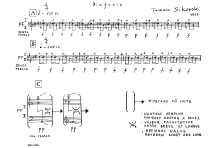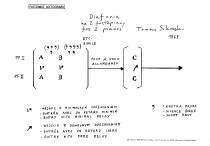Diaphony for two pianos (1969)
Diaphony can be included in the category of experimental works, which are more about expanding areas of creativity, revealing new possibilities and provoking discussion, rather than summing up a period of work. In Tomasz Sikorski’s oeuvre we can find at least two more, equally radical compositions: Without a Title (1972) and Listening Music (1973). There is no doubt that collaboration with avant-garde ensembles like Warsztat Muzyczny or Ad Novum inspired such daring experiments and provided opportunities to create them.
The whole score of Diaphony takes up just two small pages. On page one we have traditionally noted musical material of the piece, consisting of three short modules, and on page two – instructions for how to perform it. Parts I and II of the piano are identical, though the pianos do not play in unison. The way the piano parts are to be performed is described in the attached instruction. Thus, modules A and B are performed by piano II with a slight delay with regard to piano I, giving an impression that in this part of the piece the composer used hocketing. The contrasting module C in turn is performed by piano II with the delay at the performer’s discretion. The duration of the piece is not specified and depends on the performers. It is determined by the number of repetitions of the modules and the length of pauses between them.
An identical formal pattern – several repetitions of alternating modules A and B ending with module C – was used by Sikorski in a composition written two years after Diaphony, i.e. Absent-Minded Window-Gazing (1971).




